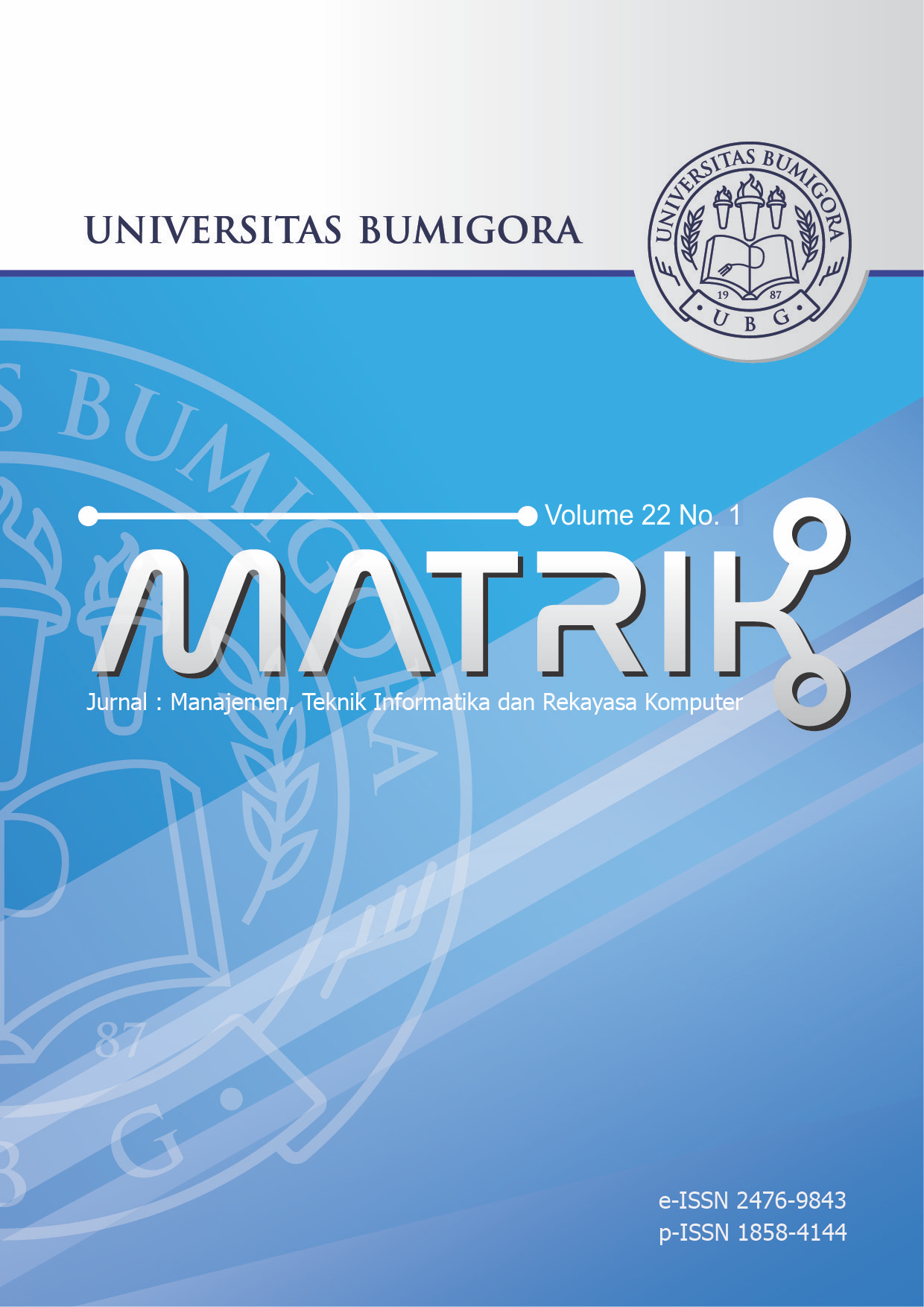The Improvement of Artificial Neural Network Accuracy Using Principle Component Analysis Approach
DOI:
https://doi.org/10.30812/matrik.v22i1.1880Keywords:
Mushroom Classification, Neural Network, Principle Component AnalysisAbstract
An important problem in a classification system is how to get good accuracy results. A way to increase the accuracy of a classifier system is to improve the number of input data attributes. Improving the number of input data attributes can be done using the Principal Component Analysis (PCA) method. The aim of this research is to reduce the number of input data attributes to increase the accuracy in a mushroom classification system. The research method used in this study started from collecting datasets from Kaggle.com related to mushroom-classification, then the data visualization process was carried out using pie charts then a dimension reduction process was carried out to reduce the number of variables using the PCA method. The next step is the training and testing of the artificial neural network. The architecture of artificial neural network used is backward error propagation with the number of hidden layers as much as 2 layers with the number of cells as many as 3 and 2. The training data used is 80%, while the testing data is 20%. Based on the test results, obtained an accuracy of 100% with 150,000 iterations and using 11 input variables from 22 existing input variables. By adding Principal Component Analysis part of the development that can improve the accuracy and performance of Artificial Neural Networks
Downloads
References
[2] I. P. Putra, “Note on Macro Fungi on Belitong Island: Description and Potential,†BIOEDUSCIENCE: Jurnal Pendidikan Biologi dan Sains, vol. 4, no. 1, pp. 11–20, 2020, doi: 10.29405/j.bes/4111-204416.
[3] I. P. Putra, “Studi Taksonomi dan Potensi Beberapa Jamur Liar di Pulau Belitong,†Justek : Jurnal Sains dan Teknologi, vol. 3, no. 1, pp. 24–31, 2020, doi: 10.31764/justek.v3i1.3534.
[4] I. P. Putra, “Kasus keracunan Inocybe sp. di Indonesia,†in Prosiding Seminar Nasional Biologi di Era Pandemi COVID-19, 2020, pp. 148–153.
[5] E. I. Haksoro and A. Setiawan, “Pengenalan Jamur yang Dapat Dikonsumsi Menggunakan Metode Transfer Learning pada Convolutional Neural Network,†Jurnal ELTIKOM : Jurnal Teknik Elektro, Teknologi Informasi dan Komputer, vol. 5, no. 2, pp. 81–91, May 2022, doi: 10.31961/eltikom.v5i2.428.
[6] R. Hayami, S. Soni, and I. Gunawan, “Klasifikasi Jamur Menggunakan Algoritma Naïve Bayes,†Jurnal CoSciTech (Computer Science and Information Technology), vol. 3, no. 1, pp. 28–33, 2022, doi: 10.37859/coscitech.v3i1.3685.
[7] I. P. Putra, “Kasus-Kasus Keracunan Jamur Liar di Indonesia,†Jurnal Ekologi Kesehatan, vol. 20, no. 3, pp. 215–230, Mar. 2022, doi: 10.22435/jek.v20i3.4943.
[8] S. K. Verma and M. Dutta, “Mushroom Classification Using ANN and ANFIS Algorithm,†IOSR Journal of Engineering (IOSRJEN), vol. 08, no. 01, pp. 94–100, 2018.
[9] J. U. Lidasan and M. P. Tagacay, “Mushroom Recognition using Neural Network,†IJCSI International Journal of Computer Science Issues, vol. 15, no. 5, pp. 52–57, 2018.
[10] E. S. Alkronz, K. A. Moghayer, M. Meimeh, M. Gazzaz, B. S. Abu-Nasser, and S. S. Abu-Naser, “Prediction of Whether Mushroom is Edible or Poisonous Using Back-propagation Neural Network,†International Journal of Academic and Applied Research, vol. 3, no. 2, pp. 1–8, 2019, [Online]. Available: http://www.ijeais.org/ijaar.
[11] R. Hanseliani, “Klasifikasi Berbagai Jenis Jamur Layak Konsumsi Dengan Metode Backpropagation,†Universitas Sanata Dharma, 2019.
[12] O. N. Putri, “Implementasi Metode CNN Dalam Klasifikasi Gambar Jamur Pada Analisis Image Processing (Studi Kasus: Gambar Jamur Dengan Genus Agaricus Dan Amanita),†Universitas Islam Indonesia, 2020.
[13] S. Enggari, A. Ramadhanu, and H. Marfalino, “Peningkatan Digital Image Processing Dalam Mendeskripsikan Tumbuhan Jamur Dengan Segmentasi Warna, Deteksi Tepi Dan Kontur,†Jurnal Teknologi Dan Sistem Informasi Bisnis, vol. 4, no. 1, pp. 70–75, 2022, doi: 10.47233/jteksis.v4i1.358.
[14] E. Tanuwijaya and A. Roseanne, “Modifikasi Arsitektur VGG16 untuk Klasifikasi Citra Digital Rempah-Rempah Indonesia,†MATRIK : Jurnal Manajemen, Teknik Informatika dan Rekayasa Komputer, vol. 21, no. 1, pp. 189–196, Nov. 2021, doi: https://doi.org/10.30812/matrik.v21i1.1492.
[15] A. S. Ritonga and I. Muhandhis, “Teknik Data Mining Untuk Mengklasifikasikan Data Ulasan Destinasi Wisata Menggunakan Reduksi Data Principal Component Analysis (PCA),†Jurnal Ilmiah Edutic, vol. 7, no. 2, pp. 124–133, 2021.
[16] A. L. Unihehu and I. Suharjo, “The Klasifikasi Jenis Ikan Berbasis Jaringan Saraf Tiruan Menggunakan Algoritma Principal Component Analysis (PCA),†Jurnal Ilmiah Ilmu Komputer, vol. 7, no. 2, pp. 27–32, 2021, doi: 10.35329/jiik.v7i2.200.
[17] H. Harizahayu, “Pengenalan Ekspresi Raut Wajah Berbasis Jaringan Saraf Tiruan Backpropagation Dengan Metode Principal Component Analysis,†BAREKENG: Jurnal Ilmu Matematika dan Terapan, vol. 15, no. 1, pp. 037–046, Mar. 2021, doi: 10.30598/barekengvol15iss1pp037-046.
[18] D. Frenza and R. Mukhaiyar, “Aplikasi Pengenalan Wajah dengan Metode Adaptive Resonance Theory (ART),†Ranah Research : Journal of Multidisciplinary Research and Development, vol. 3, no. 3, pp. 35–42, 2021, [Online]. Available: https://jurnal.ranahresearch.com/index.php/R2J/article/view/392.
[19] A. Hermawan and D. Avianto, “The Implementation of Neural Network On Determining the Determinant Factors Towards Students’ Stress Resistance,†Journal of Telecommunication, Electronic and Computer Engineering (JTEC), vol. 9, no. 3, pp. 129–133, Sep. 2017, [Online]. Available: https://jtec.utem.edu.my/jtec/article/view/1527.
[20] K. A. Widagdo, K. Adi, and R. Gernowo, “Kombinasi Feature Selection Fisher Score dan Principal Component Analysis (PCA) untuk Klasifikasi Cervix Dysplasia,†Jurnal Teknologi Informasi dan Ilmu Komputer, vol. 7, no. 3, pp. 565–572, 2020, doi: 10.25126/jtiik.2020702987.
Downloads
Published
Issue
Section
How to Cite
Similar Articles
- Reo Wicaksono, Didik Dwi Prasetya, Ilham Ari Elbaith Zaeni, Nadindra Dwi Ariyanta, Tsukasa Hirashima, Machine Learning for Open-ended Concept Map Proposition Assessment: Impact of Length on Accuracy , MATRIK : Jurnal Manajemen, Teknik Informatika dan Rekayasa Komputer: Vol. 25 No. 1 (2025)
- Rizky Hafizh Jatmiko, Yoga Pristyanto, Investigating The Effectiveness of Various Convolutional Neural Network Model Architectures for Skin Cancer Melanoma Classification , MATRIK : Jurnal Manajemen, Teknik Informatika dan Rekayasa Komputer: Vol. 23 No. 1 (2023)
- Bambang Krismono Triwijoyo, Model Fast Tansfer Learning pada Jaringan Syaraf Tiruan Konvolusional untuk Klasifikasi Gender Berdasarkan Citra Wajah , MATRIK : Jurnal Manajemen, Teknik Informatika dan Rekayasa Komputer: Vol. 18 No. 2 (2019)
- Baiq Rima Mozarita Erdiani, Aryo Yudo Husodo, Ida Bagus Ketut Widiartha, Novel Application of K-Means Algorithm for Unique Sentiment Clustering in 2024 Korean Movie Reviews on TikTok Platform , MATRIK : Jurnal Manajemen, Teknik Informatika dan Rekayasa Komputer: Vol. 24 No. 2 (2025)
- Sri Suwarno, Erick Kurniawan, Multi-Level Pooling Model for Fingerprint-Based Gender Classification , MATRIK : Jurnal Manajemen, Teknik Informatika dan Rekayasa Komputer: Vol. 22 No. 2 (2023)
- Vivin Nur Aziza, Utami Dyah Syafitri, Anwar Fitrianto, Optimizing Currency Circulation Forecasts in Indonesia: A Hybrid Prophet- Long Short Term Memory Model with Hyperparameter Tuning , MATRIK : Jurnal Manajemen, Teknik Informatika dan Rekayasa Komputer: Vol. 24 No. 1 (2024)
- Taufik Hidayat, Mohammad Ridwan, Muhamad Fajrul Iqbal, Sukisno Sukisno, Robby Rizky, William Eric Manongga, Determining Toddler's Nutritional Status with Machine Learning Classification Analysis Approach , MATRIK : Jurnal Manajemen, Teknik Informatika dan Rekayasa Komputer: Vol. 24 No. 2 (2025)
- Dairoh Dairoh, Very Kurnia Bakti, Muhammad Naufal, Neural Network dan Particle Swam Optimization untuk Penunjang Keputusan Antipasi Mahasiswa Pra Lulus Bekerja Sesuai Bidang , MATRIK : Jurnal Manajemen, Teknik Informatika dan Rekayasa Komputer: Vol. 21 No. 1 (2021)
- Nurun Latifah, Ramaditia Dwiyansaputra, Gibran Satya Nugraha, Multiclass Text Classification of Indonesian Short Message Service (SMS) Spam using Deep Learning Method and Easy Data Augmentation , MATRIK : Jurnal Manajemen, Teknik Informatika dan Rekayasa Komputer: Vol. 23 No. 3 (2024)
- Shinta Esabella, PERANCANGAN INFRASTRUKTUR JARINGAN KOMPUTER UNTUK MENDUKUNG IMPLEMENTASI SISTEM INFORMASI PADA UNIVERSITAS TEKNOLOGI SUMBAWA , MATRIK : Jurnal Manajemen, Teknik Informatika dan Rekayasa Komputer: Vol. 16 No. 1 (2016)
You may also start an advanced similarity search for this article.
Most read articles by the same author(s)
- Aditya Dwi Putro, Arief Hermawan, Pengaruh Cahaya dan Kualitas Citra dalam Klasifikasi Kematangan Pisang Cavendish Berdasarkan Ciri Warna Menggunakan Artificial Neural Network , MATRIK : Jurnal Manajemen, Teknik Informatika dan Rekayasa Komputer: Vol. 21 No. 1 (2021)
- Muhammad Rizki, Arief Hermawan, Donny Avianto, Learning Accuracy with Particle Swarm Optimization for Music Genre Classification Using Recurrent Neural Networks , MATRIK : Jurnal Manajemen, Teknik Informatika dan Rekayasa Komputer: Vol. 23 No. 2 (2024)


.png)












